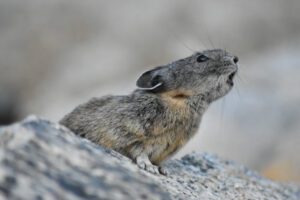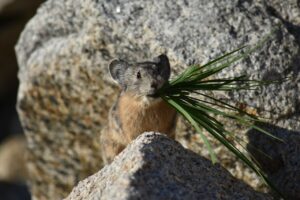
About the Author: Katherine Solari is a Postdoctoral researcher and the Associate Director of Genomics for the Program for Conservation Genomics at Stanford University. Her PhD research with Elizabeth Hadly focused on investigating the mechanisms underlying hypoxia tolerance in pikas (genus Ochotona). Her current work with the Program for Conservation Genomics focuses on developing genomic-based tools to assist in the conservation of some of the world’s most endangered species. Follow Katie on Twitter @kasolari or via her website.
I was honored to receive an AGA EECG award in 2015 as I was beginning the 5thyear of my PhD in the Hadly Lab at Stanford University. This award was granted to help me further my investigation into how species in the genus Ochotona(pikas – adorable small mammals related to rabbits) have evolved to live with limited oxygen at high elevation.

Pikas, of which there are at least 30 known species, are cold specialists, living at either high elevation or high latitude, with some species occupying some of the highest elevation habitat in the world (up to 6400m) while others live at sea-level (Smith and Xie, 2008). Pikas are particularly climate-sensitive and there is evidence that they are already undergoing range shifts due to climate change (Beever et al.,2011). In general, as climate warms, species tend to move to track their preferred temperature conditions, with flatland species shifting northward, and mountainous species moving to higher elevations (Guralnick, 2007). In the mountain-dwelling American pika there is evidence of climate change causing the loss of populations occupying lower, warmer, elevations (Beever et al., 2011). We thought that a better understanding of what mechanisms pikas use to live at these extreme elevations could offer insight into how successfully we might expect different species to shift their ranges in response to climate change. Preliminary work that we did assessing adaptations in a small number of candidate genes indicate that lower-elevation pikas do not share many of the unique genotypes that are characteristic of the high-elevation species (Solari and Hadly, 2018). In this AGA funding, we proposed to expand upon this work to assess adaptations across the pika phylogeny in thousands of potentially hypoxia-related genes.

When we proposed this work, we intended to sequence ~4000 candidate genes from 11 pika species by using a gene-capture method that would allow us to selectively sequence these 4000 genes. At the time, sequencing was still quite expensive, so it was more cost-effective to try to enrich for the genes we were interested in rather than conduct whole genome sequencing (WGS). However, soon after receiving this grant, next-generation sequencing (NGS) costs declined such that WGS of these 11 pika species became the more cost-effective option. Thus, we ended up doing WGS on these samples and generated between 9-23x coverage for each species.
Being able to pivot to WGS was very exciting because this meant that we didn’t have to limit our analysis to hypoxia-related candidate genes. With WGS data, we are now equipped to assess adaptation across the pika phylogeny in any/all genes. In particular, we can assess adaptations in genes related to heat-tolerance, cold-tolerance, and immune response. Assessing these other gene categories will provide insight into how different pika species may be expected to handle other facets of climate change. Not only are pikas going to be exposed to higher temperatures, they are also expected to experience increased cold as climate change reduces snow pack, robbing them of this insulation as they are active through the winter (Beever et al., 2010; Erb et al., 2011). They will also likely experience increased disease exposure as parasitic and infectious diseases and their vectors are also generally increasing at higher latitude and higher elevations (Gilbert, 2010; Zamora-Vilchis et al., 2012).
I was advised by numerous people during my PhD to complete all of my projects before I graduated, because it would become exponentially harder to do so once I moved on to a postdoc. Now, 4 years out of my PhD, I can say that this is 100% true. I am proud to say that I have successfully published the four chapters of my dissertation (Solari and Hadly, 2018; Solari et al., 2016; Solari et al., 2018; Solari and Hadly, 2020); however, this work funded by the AGA was not part of my dissertation (mainly because I got the funding too late into my PhD to incorporate it into my thesis) and so it still lingers. Having moved onto fulltime postdoc positions (which unfortunately are not focused on pikas) shortly after generating this data has landed me here – with this 6 year old project that I’m still very passionate about, but is still in progress.
However, there are some silver linings to having this project still open. A new American pika genome has just been published (Sjodin et al. 2021),representing a big improvement on the previous one. Additionally, in the last year, a new pika phylogeny along with genomic data for an additional 18 pika species has been published (Wang et al., 2020). As we continue to move forward with this project, we will incorporate all of this new data into our analyses, enabling a much more thorough study than would have been possible a few years ago.
References



